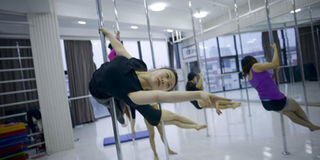Pole dancers defend their art at world championships

This picture taken on April 2, 2015 shows a group of Chinese women attending a pole dancing lesson in Tianjin. PHOTO | AFP
What you need to know:
- The scale of the competition reflects the growing appeal of pole dancing as a fitness aid over the last decade — with thousands of clubs estimated to have opened worldwide, including more than 500 in the United States alone.
- Chinese competitors said they had faced a tough environment of cultural conservatism while chasing their pole dance dreams — but that the long fight for recognition was finally paying off.
- Some serious competitors insist that the sport be referred to as "pole" or "vertical fitness" rather than pole dancing, and claim that the discipline has ancient roots in Chinese and Indian acrobatics.
BEIJING,
Erotic display or serious sport? At the World Pole Dancing Championships finals in Beijing on Sunday, competitors in skin-tight suits insisted that their challenging discipline deserves Olympic recognition.
The limber and lithe contestants from more than ten countries on four continents hope they can shed the sport's association with seedy strip clubs and win respect as skilled athletes.

A competitor performs during the semi-finals of the 2015 World Pole Dance Championships in Tianjin on April 11, 2015. PHOTO | AFP
"Pole dancing requires technical content as much as gymnastics and acrobatics, and the level of difficulty is higher," Ke Hong, a member of the Chinese team — one of the strongest in the sport — told AFP ahead of the competition.
He is one of over 50 contenders including more than a dozen men at the championships. They force themselves onto the pole for as many as eight hours a day to perfect their gravity-defying spins and poses.

This picture taken on April 2, 2015 shows a group of pole dancers warming up before a training session in Tianjin. PHOTO | AFP
"It hurts every day," He added. "The very first week, I thought about giving up."
VERTICAL FITNESS

This picture taken on April 2, 2015 shows a group of Chinese women attending a pole dancing lesson in Tianjin. PHOTO | AFP
The scale of the competition reflects the growing appeal of pole dancing as a fitness aid over the last decade — with thousands of clubs estimated to have opened worldwide, including more than 500 in the United States alone.

This picture taken on April 2, 2015 shows a pole dancer warming up before a training session in Tianjin. PHOTO | AFP
Competitors making the journey to China this year include the British current World champions 'Bendy' Kate Czepulkowski and Sam Willis, the event's organisers said.
Hotly tipped for this year's championship are the aptly-named Russian female contestant Polina Volchek, who goes by the moniker "Pink Puma", they added.
Chinese competitors said they had faced a tough environment of cultural conservatism while chasing their pole dance dreams — but that the long fight for recognition was finally paying off.
"My parents are farmers in the countryside, they do not know about this. I learned for four years, and the first three years they did not know, because I was working in a gym and I learned it secretly," said 2013 Chinese Pole Dance Champion Fang Yi.
But now "many people see it as an sport. We are working hard at it, and hope one day it will be in the Olympics," the 29 year-old added.
Some serious competitors insist that the sport be referred to as "pole" or "vertical fitness" rather than pole dancing, and claim that the discipline has ancient roots in Chinese and Indian acrobatics.
Pole dancers have launched several petitions calling for Olympic authorities to add their sport to the next Games — so far without success.

A competitor warms up before the semi-finals of the 2015 World Pole Dance Championships in Tianjin on April 11, 2015. PHOTO | AFP
"In past years, the bars have required dancers to be more athletic and it's no longer a sexual thing. A few years ago, it was more of a sexual thing, but now it's more of an athletic thing," said Chinese dancer Sun Wenzhu, as she painted a "wolf" mask to be used in her competition appearance.





